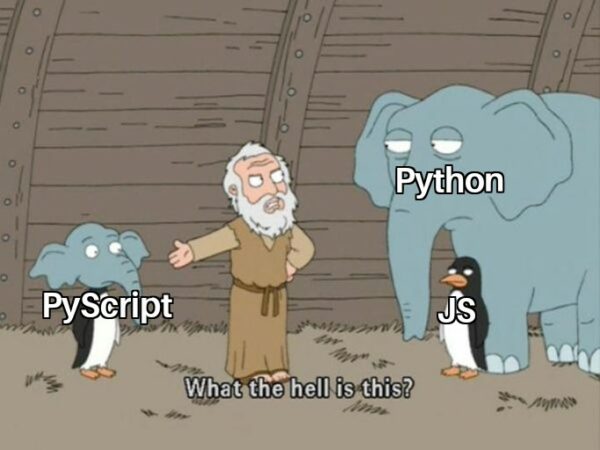Tag Python
Bunny.net is an excellent cloud storage and CDN service. I use it for my websites. Bunny offers two primary services: Bunny Storage and Bunny Pull Zones. Combined those two comprise Bunny CDN. There are additional services DNS, Stream (video), and… Continue Reading →
This article is about PyScript and the MongoDB Data API. I have not used the MongoDB Data API before. I know MongoDB and PyScript fairly well, so I thought I would document my journey to see if they will work… Continue Reading →
This article is about deploying a PyScript application on Deno Deploy. If you are familiar with Deno and Deno Deploy then you already know that Deno is a JavaScript framework and deploy service. Why deploy PyScript on a JavaScript platform?… Continue Reading →
Some of the PyScript WASM files are large. For example, pyodide.asm.wasm is ~9.5 MB. Correctly setting up your web server to serve these files takes some consideration. You should configure several items in your web server. This article covers Apache… Continue Reading →
Knowing that an error occurred is the first step to preventing and solving errors. There are many types of errors that PyScript applications will experience. Network failures, resources not being available and programming mistakes are just a few problems to… Continue Reading →
PyScript PWA Creating installable PyScript applications that cache assets and runs offline offer enormous potential for Python. In this article, I will show you how to create a Python application that installs on the desktop and on mobile devices. This… Continue Reading →
In PyScript, as well as JavaScript, there are only a few methods of getting data into your program: Read data from the local file system Read data from the network Input data from the user Create data inside your application… Continue Reading →
A recent article by Luciano Abriata criticized PyScript. He made two statements: Pyscript is way too slow and heavy to load. Does not support all of Python’s features and libraries. He then provided two example programs link and link. The… Continue Reading →
In this article, I will show how to use the File System Access API. This API is a web platform API that enables developers to build powerful web apps that interact with files on the user’s local device. There are… Continue Reading →
This article discusses downloading and building PyScript from the source for Ubuntu 20.04 running within Windows WSL. For Linux, skip over the first section covering WSL setup. This article is written for the Python developer with limited experience building JavaScript/Node.js… Continue Reading →
As momentum builds for PyScript, a few good resources are being created. This article is my attempt to keep track of the ones that are very good and/or have detailed knowledge. Please let me know if you know of one… Continue Reading →
This will be the first of several articles that provides details on Pyscript files and file systems. I will discuss the different virtual file systems and how to access files located on the desktop. I have put each example in… Continue Reading →
Introduction If you are familiar with using the Canvas with JavaScript, then you will quickly know how to draw on the Canvas with Python knowing a couple of minor items. If you are a Python developer new to drawing inside… Continue Reading →
Introduction There are times that you want to write pure HTML and JavaScript code and during runtime download and execute Python code based upon various criteria. This article shows how to create the <py-script> tag, load code into the py-script… Continue Reading →
Introduction Setting up Python event handlers in Pyscript requires special handling. Pyodide provides a proxy so that DOM events can use Python functions as callbacks. To create a proxy, call the pyodide.create_proxy() function [link].
|
1 2 3 4 |
from pyodide import create_proxy # Create a Python proxy for the callback function function_proxy = create_proxy(myFunction) |
The Python function myFunction is… Continue Reading →
Introduction I have noticed an interesting anomaly between Pyodide and Pyscript. Pyscript takes about one second longer to load an HTML + Python page than Pyodide. Pyodide averages 2 seconds and Pyscript 3 seconds. Other interesting stats: Downloads: Pyodide downloads… Continue Reading →
Introduction Pyscript/Pyodide supports excellent interoperability between JavaScript and Python. Python can call JavaScript and JavaScript can call Python. DOM events can use Python functions as callbacks. This article covers Python calling JavaScript functions and how to pass and receive data… Continue Reading →
Introduction Today, you can now use Pyscript to run Python code in the web browser. This has enormous potential for AI, ML, Data Scientists, and regular Python developers. I often develop backend applications in Django and Flask, and the possibilities… Continue Reading →
Introduction This article demonstrates how to set up a Windows development system with Python and the Azure SDK for Python. After my article, Azure – Lock a VM to Prevent Deletion, I wrote the Azure CLI equivalent commands in Python…. Continue Reading →
Introduction I recently had a conversation with the Principle Security Architect for a large company concerned with security, identity, and access management. He asked me, “What language do you write your code in and why?”. I answered his question with… Continue Reading →
Socratica Python Kickstarter Campaign Introduction from Socratica’s Kickstarter Campaign Socratica – a small educational film studio with big dreams. You know us for our high-quality video lessons about math, science, and programming, especially PYTHON. Over the course of five… Continue Reading →
Introduction I watch a lot of training material from all the major education vendors (Pluralsight, Linux Academy, Cloud Academy, A Cloud Guru, and many others). For a long time, I have been wanting to add professional scriptwriting, and professional graphics… Continue Reading →
Table of Contents Introduction Definitions Example Private & Public Keys OpenSSH Public Keys SSH-2 Public Keys Examining OpenSSH Public Keys Introduction There is a lot of confusion and inaccurate information on the Internet about Key Pairs and Private/Public keys. This… Continue Reading →
Introduction On August 15, 2018, Google released the Alpha release of Google Cloud Run. Many of us saw the potential and went to work learning this new platform. Everything serverless gets our attention. Cloud Run is Google’s entry into serverless… Continue Reading →
This article shows how to display a list of Google Cloud Projects that you have access to list. This article includes two examples in Python that use two different Google Cloud Python libraries. These examples produce the same output as the… Continue Reading →



















